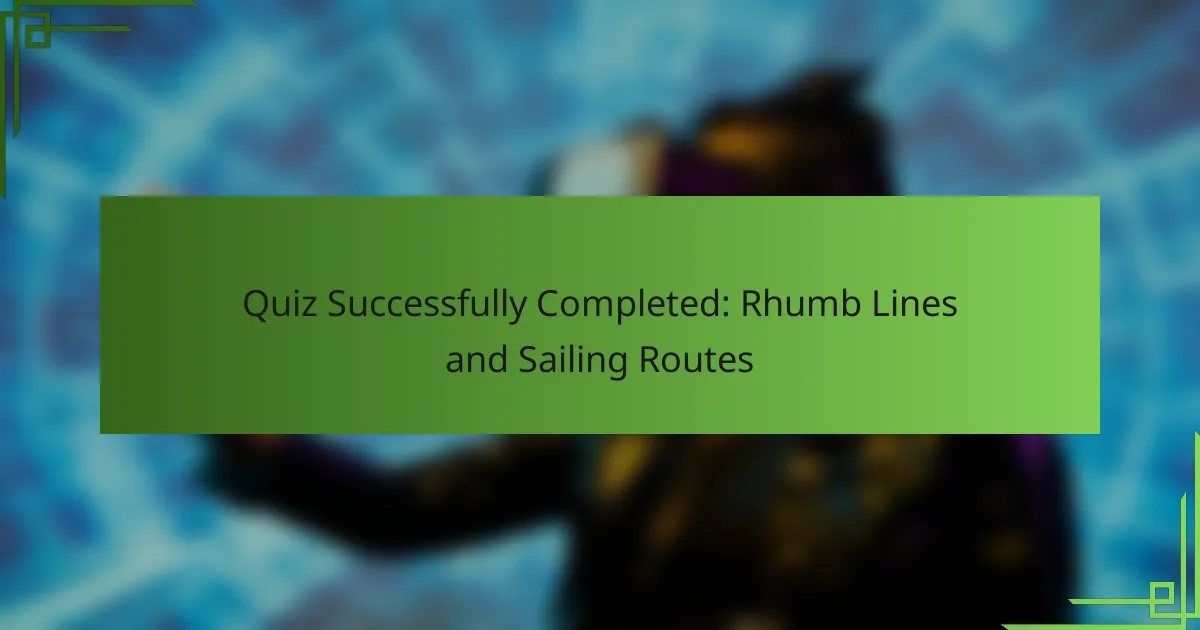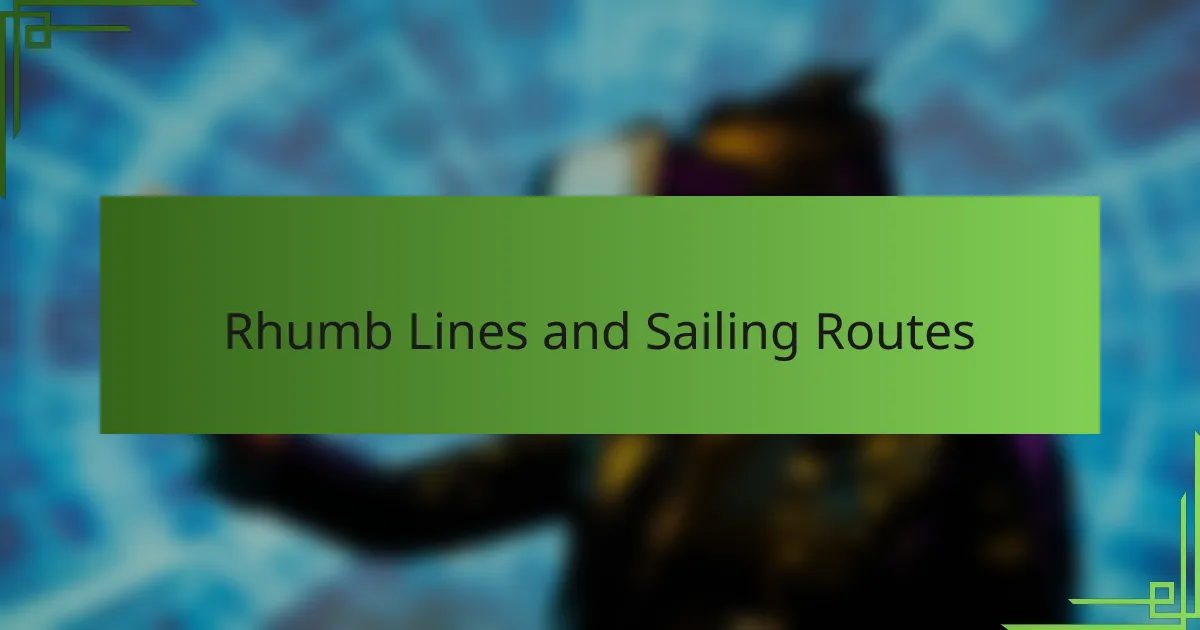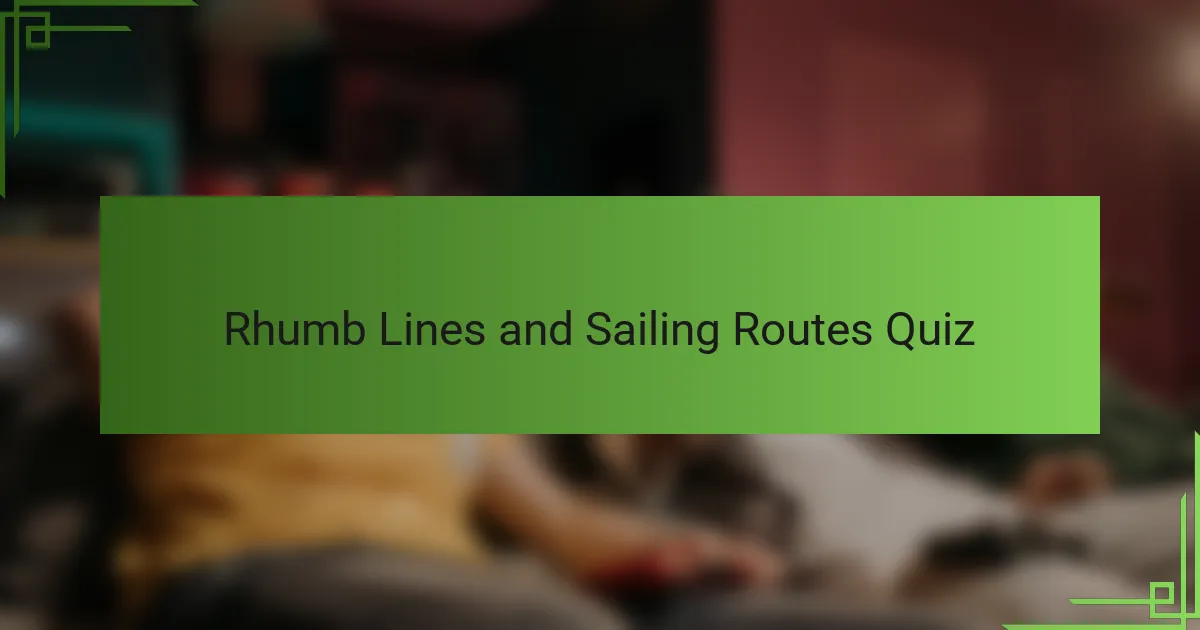
Rhumb Lines and Sailing Routes Quiz
1. What is the primary characteristic of a rhumb line in nautical navigation?
- A path following the shortest distance between two points on a sphere
- A route maintaining a constant distance from the equator
- A line formed by connecting points of equal magnetic declination
- A line of constant compass bearing crossing all meridians at the same angle
2. How do rhumb lines differ from great circle routes on a globe?
- Rhumb lines follow the shortest distance between two points, but great circle routes maintain a constant compass direction.
- Rhumb lines cross all meridians at the same angle, whereas great circle routes represent the shortest distance between two points on a globe.
- Rhumb lines change angles as they cross meridians, whereas great circle routes keep a fixed angle with all meridians.
- Rhumb lines curve to avoid polar regions, while great circle routes are straight lines on any map projection.
3. Which ancient civilization is credited with the first recorded use of rhumb lines in sailing?
- Phoenicians
- Ancient Greeks
- Egyptians
- Romans
4. What is the name of the map projection that preserves rhumb lines as straight segments?
- Mercator projection
- Robinson projection
- Winkel Tripel projection
- Gall-Peters projection
5. How did Christopher Columbus use rhumb lines during his voyages across the Atlantic?
- Columbus used rhumb lines on his maps to maintain a constant compass direction, aiding in navigation across the Atlantic.
- Columbus used rhumb lines to track wind patterns and predict storms during his voyage.
- Columbus used rhumb lines to estimate the distance between islands for resupply stops.
- Columbus used rhumb lines to measure the depth of the ocean along his route.
6. On a Mercator projection map, what is the significance of straight lines representing sailing routes?
- They depict the path of ocean currents which aid in navigation.
- They indicate the shortest distance between two points on the globe, known as great circle routes.
- They represent lines of constant compass bearing, known as rhumb lines or loxodromes.
- They mark political boundaries important for maritime territorial claims.
7. Why are rhumb lines especially useful for pilots and mariners navigating oceans?
- They are based on magnetic north rather than true north, improving accuracy.
- They represent the shortest distance between two points on the Earth`s surface.
- They account for changes in ocean currents and winds automatically.
- They allow a constant compass bearing, simplifying navigation over long distances.
8. Which famous explorer`s routes were often planned using rhumb lines for easier navigation?
- Vasco da Gama
- James Cook
- Ferdinand Magellan
- Christopher Columbus
9. How does the concept of a rhumb line simplify the process of plotting a course on a nautical chart?
- A rhumb line maintains a constant compass direction, allowing navigators to plot a straight line on a Mercator projection chart.
- A rhumb line represents the shortest distance between two points on the globe, simplifying distance calculations.
- A rhumb line curves to follow the natural shape of coastlines, making coastal navigation easier.
- A rhumb line automatically adjusts for tidal currents when plotted on nautical charts.
10. What geometric property do rhumb lines maintain as they cross meridians?
- They maintain a constant angle with all meridians
- They maintain a variable angle with meridians that adapts for shortest distance
- They maintain a constant latitude along their course
- They maintain a constant distance from the equator
11. Which European age of exploration figure extensively utilized rhumb line navigation to reach new continents?
- John Cabot
- Ferdinand Magellan
- Christopher Columbus
- Vasco da Gama
12. How does the length of a rhumb line compare to that of the great circle route between two points on Earth?
- A rhumb line is only shorter than a great circle route near the equator.
- A rhumb line is always shorter than the great circle route between two points.
- A rhumb line is generally longer than the great circle route between two points on Earth.
- A rhumb line and a great circle route are always the same length.
13. In relation to the Prime Meridian, what constant angle does a rhumb line maintain on a globe?
- A constant latitude line
- A constant bearing or compass direction
- A line connecting the North and South Poles
- A constant distance from the equator
14. What tool did early navigators use in conjunction with rhumb lines to set their sailing courses?
- Chronometer
- Astrolabe
- Magnetic compass
- Sextant
15. Which world ocean`s early trade routes were heavily influenced by rhumb line navigation techniques?
- Arctic Ocean
- Pacific Ocean
- Indian Ocean
- Atlantic Ocean

Quiz Successfully Completed: Rhumb Lines and Sailing Routes
Congratulations on completing the quiz about rhumb lines and sailing routes. This quiz has provided an opportunity to explore essential concepts in geography related to navigation and map reading. You have reviewed how rhumb lines help sailors maintain a constant compass direction, which is crucial for plotting efficient courses across the oceans.
Throughout the quiz, you may have learned the differences between rhumb lines and great circle routes, understanding their unique advantages and limitations. These insights deepen your appreciation for how geography influences travel and exploration. Recognizing the practical applications of these navigation techniques enhances your knowledge of maritime history and modern sailing practices.
We invite you to visit the next section on this page, where you can find more detailed information about rhumb lines and sailing routes. This resource will expand your understanding through maps, examples, and real-world applications. Keep exploring to strengthen your grasp of geography and the art of navigation.

Rhumb Lines and Sailing Routes
Definition and Principles of Rhumb Lines in Geography
Rhumb lines, also known as loxodromes, are paths on the Earth’s surface that cross all meridians at a constant angle. This property makes them significant in navigation and geography as they represent a course of constant compass direction. Unlike great circle routes, rhumb lines are easier to follow because they require maintaining a single compass bearing. Gerardus Mercator, the Flemish cartographer, developed the Mercator projection, which represents rhumb lines as straight lines, facilitating their use in navigation.
The Importance of Rhumb Lines in Historical Sailing Routes
Rhumb lines played a crucial role in the Age of Exploration by enabling sailors to chart consistent courses across vast oceans. Navigators on ships, such as those commanded by Christopher Columbus or Vasco da Gama, relied on rhumb lines to maintain steady headings using magnetic compasses. Although not the shortest path between two points, rhumb lines simplified maritime navigation, reducing the complexity of steering a variable course, especially before the advent of modern navigation tools.
Comparison Between Rhumb Lines and Great Circle Routes in Marine Navigation
Great circle routes represent the shortest distance between two points on a sphere, following a path along a great circle. However, great circle routes are complex to navigate as the bearing continuously changes. Rhumb lines provide constant compass directions, making them straightforward to steer, though they result in longer distances. Modern navigation balances these approaches: long transoceanic flights use great circle routes for efficiency, while rhumb lines are favored for simpler, routine marine navigation due to ease of course-keeping.
Mathematical Characteristics of Rhumb Lines on the Mercator Projection
On the Mercator projection, developed in 1569 by Gerardus Mercator, rhumb lines are represented as straight, parallel lines. This cylindrical map projection preserves angles, making it conformal, and ensures that loxodromes appear as straight lines intersecting meridians at constant angles. Mathematically, a rhumb line spirals towards the poles, crossing meridians at a consistent azimuth. This property simplifies calculations and course plotting in nautical charts that sailors traditionally used.
Modern Applications of Rhumb Lines in Geographic Information Systems (GIS) and Navigation
Today, rhumb lines continue to be integral in geographic information systems (GIS) and maritime navigation technologies. Electronic chart display and information systems (ECDIS) use rhumb lines for route planning and waypoint navigation. GPS and digital mapping employ algorithms that account for rhumb line paths when plotting routes with fixed compass headings. Their principles support coastal navigation, fishing operations, and recreational sailing by providing straightforward routes aligned with compass bearings.
What is a rhumb line in geography?
A rhumb line, also called a loxodrome, is a path crossing all meridians at the same angle on the Earth’s surface. It represents a constant compass bearing, making it valuable in navigation. Unlike great circles, which represent the shortest distance between two points, rhumb lines spiral toward the poles but provide a straightforward route for maintaining a steady course. The concept of rhumb lines has been used in maritime navigation since the Age of Discovery, evidenced by historical nautical charts from the 16th century.
How are rhumb lines used in sailing routes?
Rhumb lines are used in sailing routes to maintain a consistent compass direction, simplifying navigation. Sailors follow a rhumb line to avoid frequent changes in heading, which was especially important before advanced navigation tools existed. For example, early explorers like Ferdinand Magellan utilized rhumb lines to chart courses across vast oceans. This method trades off route efficiency for navigational ease, which remains relevant in certain coastal and mid-ocean voyages.
Where on Earth’s surface do rhumb lines become impractical for navigation?
Rhumb lines become impractical near the Earth’s poles, as they spiral infinitely toward them instead of following a direct route. Navigating close to the poles using a rhumb line results in excessively long routes. This limitation is due to the convergence of meridians at the poles, which causes the constant compass bearing to create a spiraling path, not a straight line. Polar navigation typically relies on great circles to minimize distance.
When did the use of rhumb lines become prominent in maritime navigation?
The use of rhumb lines became prominent during the 15th and 16th centuries, coinciding with the Age of Exploration. Mariners like Portuguese and Spanish explorers adopted rhumb lines on Mercator projection maps, introduced by Gerardus Mercator in 1569. These maps allowed rhumb lines to be represented as straight lines, facilitating more accurate and consistent route planning across oceans during that period.
Who developed the Mercator projection that made rhumb line navigation easier?
Gerardus Mercator, a Flemish cartographer, developed the Mercator projection in 1569. This cylindrical map projection preserves angles, making rhumb lines appear as straight lines on the map. Mercator’s innovation enabled sailors to plot courses with consistent compass bearings more efficiently, revolutionizing navigation and simplifying the use of rhumb lines for maritime routes.
